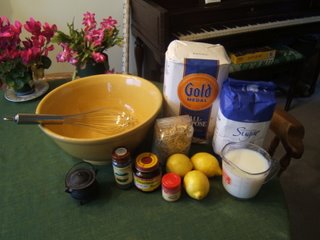
Valbo arrives!
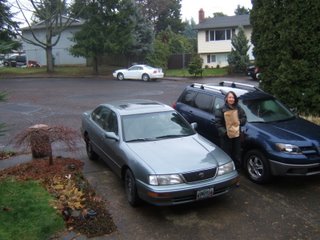
Before coffee....
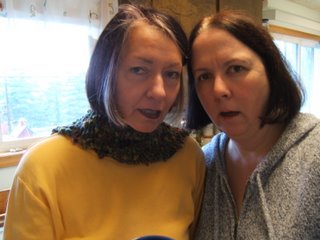
Measuring, scalding the milk, melting the butter....

The bread bowl goes back for at least four generations in my maternal family.

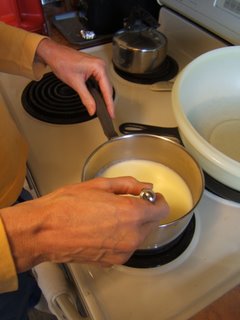
Behold, the miracle and magick of the yeast!
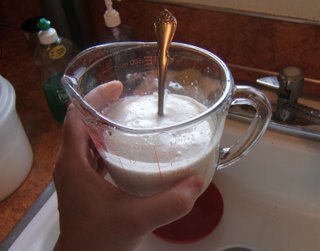
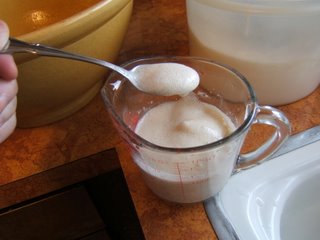
After coffee.... (Maybe coffee is to tired women as yeast is to deflated bread dough?)

Adding flour....
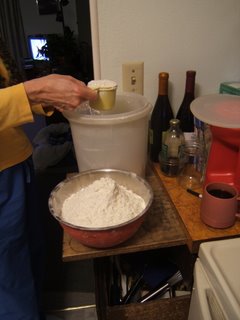

Ernie seemed unimpressed. But can this position really be comfortable?

Eggnog-- nothing like a bit of energy mid-way!
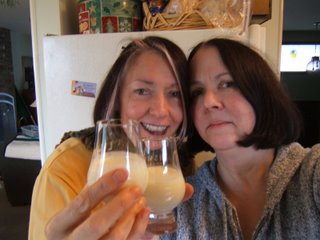
After a lot of kneading, the first batch of dough was ready to rise. We used my office as our rising room, thanks to the toasty wee electric 'fireplace' in the corner.
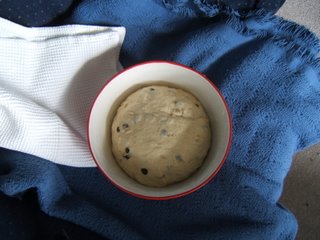
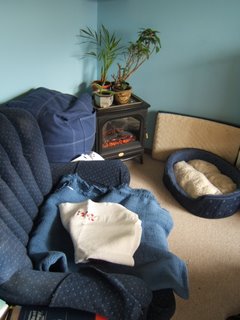
During the first rising, we dashed to Albertsons for eggs and a couple of extra lemons-- a quick jaunt. Little did we know it would be the first of three store trips we'd make that day.
By the time we put the dough down for a second rising, we'd realized that we didn't have any candied pineapple. Horrors! This time, we headed to Sheridan . Could we have gotten away without using pineapple to decorate the loaves? Nope. Mom would have noticed. It was fun, though. Sheridan is this really amazing greengrocer on Portland's industrial east side. Lots of wonderful produce, artisan cheeses, imports, good wine, etc.
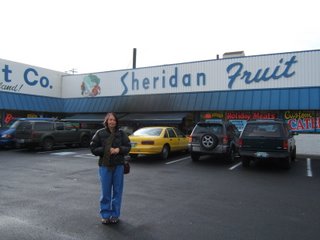
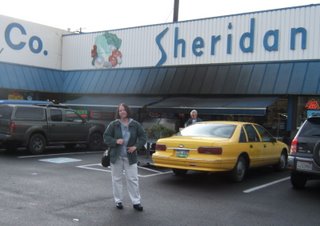


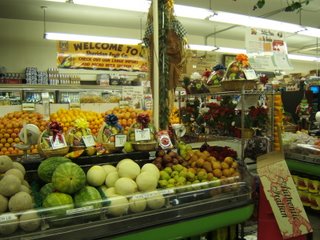
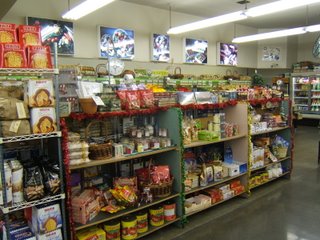
On the way home, we picked up a Papa Murphy's pizza for lunch.

The risen dough was punched down and shaped into loaves. You start with "ropes," and braid these to form the main loaf. Smaller braids top the larger ones.
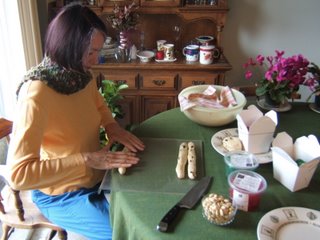
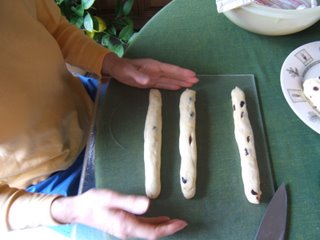
The loaves are decorated with nuts and fruit, brushed with an egg wash, and sprinkled with poppyseed.

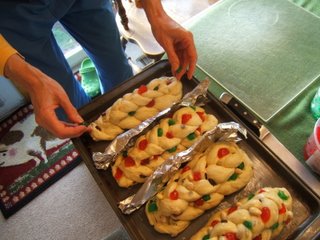
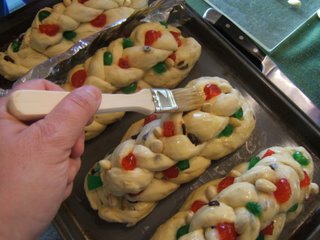
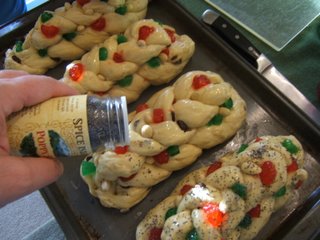
Pizza break.... Funny that Ernie work up right about then.



We made four batches, so repeated the whole process four times!

When the loaves came out, they got a nice brush with melted butter and a rest under a clean towel.

We had to return to the store for a third time, when we realized we needed plastic bags and a couple of other things. By then it was very dark outside.




Those of you who know me won't be surprised at all by knowing that I always put up holiday lights inside of 'Xena, Warrior Car.'
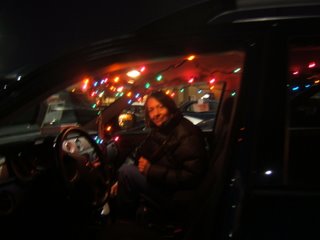
Here are some of the fnished loaves-- we made 4 batches, or 16 loaves.
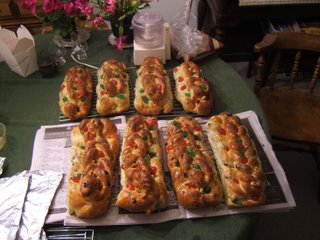
And of course we had to have a sample.
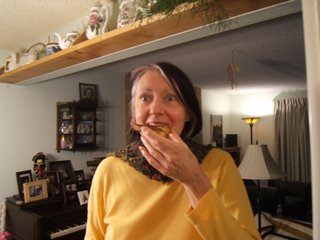
Valerie's Bill brought Thai take-out. My Bill poured eggnog all around.

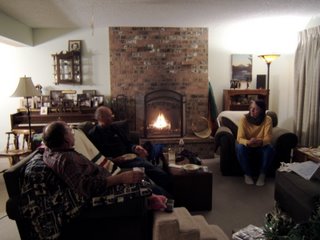
Bye, Valbo. See you next year....

For those of you who survived this photo essay and might be interested, here's the recipe.
Hoska
2 C. milk
1/2 C. sugar
2 tsp. salt
1/2 tsp. grated fresh lemon zest (peel)
1/2 tsp. mace
1/2 C. warm water (110-115°)
2 packages fresh dry yeast
1/2 C. unsalted butter
1/2 C. cold water
4 eggs, well beaten (reserve 1 T. for glaze)
1 T. fresh lemon juice
1 C. raisins and currants
1 C. chopped, peeled almonds
10+ C. flour (all-purpose, bread flour, or a combination of both)
Candied pineapple (green) and candied cherries (green and red), for garnish
Whole almonds, peels removed, for garnish
Poppy seed, for garnish
Scald the milk. (Do this first and it will scald and begin to cool while you get other items ready.)
Combine sugar, salt, lemon peel, and mace in a very large bowl and set aside.
Dissolve the yeast in the warm water, stirring thoroughly. Set aside.
Add the butter to the scalded milk. Stir until melted. Add this mixture to the sugar-salt mixture. Stir well. Add the 1/2 C. cold water and stir again.
When this mixture has cooled to below 115°, add the yeast mixture, eggs, and lemon juice. Stir well.
Begin adding flour, 1 cup at a time. Stir in with a wooden spoon. After 6 C. of flour have been incorporated, add the raisins and chopped almonds.
You’ll likely use at least 10 cups of flour, but don’t be afraid to use a bit more or less—aim for a dough that remains sticky enough to almost—but not quite—stick to the surface as it is kneaded. After all the flour has been added, turn the dough out and knead for 5-10 minutes. You may actually have to “knead in” the last cup or two if stirring becomes too difficult. The end-point for kneading is when the dough is satiny, barely "tacky" to the touch, and blistery.
Place the dough in a clean, oiled bowl, turning the dough so that all sides are oiled. Cover with waxed paper and then with a clean towel. Leave to rise in a warm room until doubled*, 1 1/2-2 hours.
When doubled, punch down** and let rise again for about 45 minutes, until close to redoubled.
Divide the dough into four portions. Each of these will make 1 loaf of bread. Cover portions 2-4 with a towel so they won't dry out.
Divide portion 1 into fourths—we’ll call these A, B, C, and D. Set D aside covered with a towel—this will become the small braid that sits atop the loaf.
Roll and shape A-C into three "ropes" of the same length (12-16" long). Braid these, squeezing the ends together so they won't spring apart when the dough rises. This will form the large braid that makes up the bottom of the loaf. (Note: if you aren’t happy with your braid, start over! Bread dough is very forgiving!)
Take portion D and divide it into three pieces. Form each piece into three “ropes” of the same length (about about 12”) and braid them into a small braid Arrange this braid atop the larger one. You should now have a finished load that looks like a big, plump braid topped by a very small decorative braid.
Repeat with the reserved dough (portions 2-4). In the end you will have four finished loaves.
Place each loaf (as you make it) on a lightly greased cookie sheet. Decorate by pushing almonds and candied fruit into the "holes" in and between the braids. Be liberal with the decorations—they will make the loaves festive. Push the almonds and fruit deeply into the dough, so that they don’t “pop out” as it rises; however, be careful not to crush the braids.
Brush the finished loaves with the reserved beaten egg*** (thinned with a dab of water) and sprinkle lightly with poppy seed.
Cover loaves with waxed paper and towels and leave in a warm place to rise until they appear doubled (don't stick your fingers in to test!).
Bake at 325° for 40-50 minutes. Turn cookie sheets around once, midway through the baking. Check at the 35 minute mark—if already a dark golden, cover loosely with a shield of foil to prevent over-browning.
The loaves are done when they are a deep golden and smell heavenly. If you lift one and thump with your finger on the bottom of the loaf, it should sound hollow.
Notes:
Hoska stores at room temp for at least a week, and also freezes well.
* To test, poke two fingers deeply into the dough. If the dough has doubled, two deep holes will remain.
**To punch down, literally punch and hit the dough with your fists, driving out all of the air and air bubbles (which is exactly the point--this is how out pioneer forebearers took out their frustrations!). You can also pick it up and slam it down on a countertop.
***The egg yolk wash gives the bread its golden color. Make sure to spread it over every nook and cranny for a uniform glaze.
2 comments:
i survived! : )
Please save some Hoska for my trip. See you soon!!
That was fun! I almost felt like I was there. :)
Post a Comment